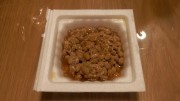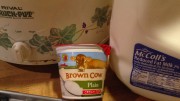I was SOOOOO excited to learn that cottage cheese is a probiotic food. I love it, especially in the summer when its cold creaminess added to a salad makes a wonderfully light and refreshing lunch or dinner. Sigh.
And it’s not hard to make, either, and homemade tastes SOOOO much better than store bought. . .so I was thinking that we have a home run here on the homemade/healthy front.
But then I started doing some research. Turns out, I can’t find a homemade recipe for a cottage cheese that is made in such a way that the probiotic microorganisms are developed. Apparently, you need the benefits of a factory full of scientists and sophisticated equipment to get things right.
You can BUY a lot of brands that are probiotic, however. . .Breakstone is one. Trader Joes’s is another. Horizon Organic is a third. And your local health food store probably has other brands that fit the bill.
But, although, I am excited about the thought of cottage cheese as a probiotic food, I’m not as excited about paying retail prices for a specialty product, no matter how wonderful.
So what’s a thrifty Practical Pioneer to do? Well, I put my prairie bonnet on (figuratively, that is, as a thinking cap of sorts!), and did some thinking.
The problem is that probiotic microorganisms develop during fermentation, which takes time. But fresh cottage cheese doesn’t have a very long shelf life. So, without the benefit of fancy equipment and staff scientists to monitor the fine line between healthy and toxic, I had to come up with some way to speed the process up or mimic it in some way.
And then I thought. . .one of the ingredients you add after making the cottage cheese curds is a little cream, which binds the curds and lends the rich, creamy finish. But what if you added something in cream’s place? What if you added something that is already teeming with the healthy organisms you are after?!?! Light bulb!!
Homemade yogurt (and many store varieties) are, indeed, teeming with probiotic cultures! So, adding in some yogurt in place of heavy cream will accomplish both the binding creaminess AND the microorganisms you’re hankering for! Ta-da!!!
So, here’s my recipe for a delicious homemade AND probiotic cottage cheese. . .
Equipment:
- Large Saucepan
- Large Colander
- Mixing Bowl
- Cheese Cloth (or thin tea towel)
- Thermometer
- Measuring Spoons and Cups
Ingredients:
- One Gallon of 2% Milk (other milks work okay, too)
- 3/4 Cup White Vinegar
- 1-2 Teaspoons Sea Salt (to taste)
- 1/2 Cup Plain Homemade Yogurt, or Greek Yogurt (or you can blend the yogurt with some heavy cream until you get the flavor you are happy with).
Method:
- Pour milk into your saucepan and heat over medium.
- Stir occasionally until the milk reaches 120-130 degrees F.
- Take off heat and slowly add the vinegar, stirring constantly for 2 minutes.
- Cover and leave at room temperature for about 30 minutes. (the curds will begin to separate from the whey during this time)
- Carefully pour the whole lot into the cloth lined colander, saving the whey for baking, etc., if you wish
- Leave to drain for 5 to 10 minutes
- Rinse under cold water until cool, gently stirring the curds so they don’t break up too much
- When completely cooled, twist the cloth around the curds to squeeze out as much liquid as possible
- Transfer to a mixing bowl and break up any large chunks
- Add your yogurt, or your yogurt and cream blend, until you’re happy with both the taste and consistency.
- Salt to taste.
- Serve immediately, or store, tightly covered, in the fridge for up to two days.
Remember that the probiotic benefits of foods are killed or minimized when heating, so if you’re going to the trouble of making a probiotic cottage cheese and then use it in a lasagne, you’re defeating your purpose. Probiotic foods are best eaten without being heated (warmed gently is sometimes okay).
Time to make Ma Ingalls’ good Cottage Cheese Balls with Onions! 🙂
(Photo courtesy of publicdomainpictures.net and can be found here)






Be the first to comment on "Cottage Cheese: Probiotic Food"